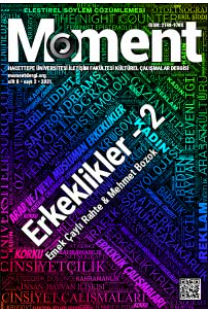BİLİMSEL İLETİŞİM VE LİTERATÜR KULLANIM KÜLTÜRÜ: LİTERATÜR ESKİMESİ ÜZERİNDEN BİR DEĞERLENDİRME
Bu çalışmada atıf analizi yöntemi kullanılarak, iletişim bilimlerinde faaliyetlerde bulunan akademisyenlerin literatür kullanım örüntüleri üzerine çıkarsamalarda bulunulmuştur. Günümüzün değişen şartlarına bağlı olarak disiplinler arasındaki sınırların ortadan kalmaya başladığı söylenebilir. Bilgi ve iletişim teknolojilerinde yaşanan gelişmelerin disiplinleri doğrudan etkilediği, hatta sosyal bilimlere yönelik yeni tanımlamalara neden olduğu da görülmektedir. Dijital İnsani bilimler, hesaplamalı sosyal bilimler, hesaplamalı dilbilimleri vb. gibi tanımlamalar da bu etkileşimin bir sonucu olarak karşımıza çıkmaktadır. Bu gelişmeler doğrultusunda iletişim bilimlerindeki bilimsel kaynak kullanımını ölçebilmek için atıf analizinden faydalanılmıştır. 1990-2018 yılları arasında Web of Science’ın kitap indeksinde Communication alanında dizinlenen kitap ve kitap bölümlerine dair bibliyografik veriler incelenmiştir. Yıllık büyüme oranı bakımından iletişim bilimleri literatürünün üstel (exponential) büyüme eğrisine yakın seyrettiği gözlemlenmiştir. İletişim alanında yayımlanan kitap/kitap bölümlerinde dergi kullanımının dergi dışı materyal kullanımına oranla daha düşük olduğu tespit edilmiştir. Dergi kullanımın diğer kaynak türlerine göre daha yoğun olduğu alt alanların “Audiology & Speech-Language Pathology”, “Psychology” ve “Behavioral Sciences” olduğu gözlemlenmiştir. İletişim bilimleri alanında tüm yıllar ve tüm konu alanları için literatür yarı yaşamı 9 yıl olarak hesaplanmıştır. Yarı yaşamın en yüksek hesaplandığı alan 26 yıl ile tarih olurken, en düşük olduğu konu alanı ise kamu yönetimi olmuştur.
SCHOLARLY COMMUNICATION AND LITERATURE USAGE CULTURE: AN EVALUATION FROM THE LITERATURE OBSOLESCENCE
In this study, inferences were made on the literature usage patterns of the academicians involved in Communication Sciences with the method of citation analysis. Depending on the changing conditions of today, it is possible to say that the boundaries between the disciplines are disappearing. It is also seen that the developments in Information and Communication Technologies directly affect the disciplines and even cause new definitions for Social Sciences. “Digital Humanities”, “Computational Social Sciences”, “Computational Linguistics” and so on definitions such as these are the result of this interaction. In line with these developments, citation analysis was used to measure the use of scientific resources in Communication Sciences. Between 1990 and 2018, the bibliographic data of books and book chapters indexed in the field of Communication in the Book Citation Index of Web of Science were examined. In terms of annual growth rate, Communication Sciences literature has been observed to be close to exponential growth curve. In the book / book chapters published in the field of Communication Sciences, it was found that the use of journals was lower than the use of non-journal materials. “Audiology & Speech- Language”, “Pathology”, “Psychology” and “Behavioral Sciences” are the sub-areas where journal usage is more intense than other types of sources. For all years and all subject areas in the field of Communication Sciences, half-life is calculated as 9 years. The highest area of half-life was History with 26 years, while the lowest was the Public Administration as 7 years.
___
- Al, U., & Coştur, R. (2007). Türk Psikoloji Dergisi’nin bibliyometrik profili. Türk kütüphaneciliği, 21(2), 142-163.
- Buchanan, A. L., & Herubel, J. P. V. M. (1997). Disciplinary culture, bibliometrics, and historical studies: Preliminary observations. Behavioral & Social Sciences Librarian, 15(2), 37-53. doi:DOI 10.1300/J103v15n02_03
- Cronin, B., Mckenzie, G., & Stiffler, M. (1992). Patterns of Acknowledgment. Journal of Documentation, 48(2), 107-122. doi:DOI 10.1108/eb026893
- Daniel, D. (2016). Journal Articles are the Most Widely Used Information Resource for Research and Teaching in all Academic Disciplines. Evidence Based Library and Information Practice, 11(3), 99-101. doi:Doi 10.18438/B8hs6m
- Hakanen, E. A., & Wolfram, D. (1995). Citation Relationships among International Mass- Communication Journals. Journal of Information Science, 21(3), 209-215. doi:Doi 10.1177/016555159502100306
- Hollman, K. W., Murrey, J. H., & Homaifar, G. (1991). The Structure and Disciplinary Boundaries of Insurance - a Citational Analysis of Jri Articles. Journal of Risk and Insurance, 58(4), 714-721. doi:Doi 10.2307/253082
- Karki, R. (1996). Searching for bridges between disciplines: An author co-citation analysis on the research into scholarly communication. Journal of Information Science, 22(5), 323-334. doi:Doi 10.1177/016555159602200501
- Liu, Z. M. (2003). Trends in transforming scholarly communication and their implications.Information Processing & Management, 39(6), 889-898. doi:10.1016/S0306-4573(02)00057-2
- McDonald, J. D. (2007). Understanding journal usage: A statistical analysis of citation and use. Journal of the American Society for Information Science and Technology, 58(1), 39- 50. doi:10.1002/asi.20420
- Mine, S. (2004). On the scholarly use of electronic journals: Trends and issues from the mid 1990s. Library and Information Science(51), 17-39.
- Osareh, F. (1996). Bibliometrics, citation analysis and co-citation analysis: A review of literature .1. Libri, 46(3), 149-158. doi:DOI 10.1515/libr.1996.46.3.149
- Rowlands, I. (1999). Patterns of scholarly communication in information policy: A bibliometric study. Libri, 49(2), 59-70. doi:DOI 10.1515/libr.1999.49.2.59
- Sandstrom, P. E. (2001). Scholarly communication as a socioecological system. Scientometrics, 51(3), 573-605. doi:Doi 10.1023/A:1019655305286
- Ucak, N. O. (2011). Information Use in Art: A Citation Analysis of Sources Used in Art Theses in Turkey. Journal of Academic Librarianship, 37(1), 77-81. doi:DOI 10.1016/j.acalib.2010.10.010
- Ucak, N. O., & Al, U. (2009). The Differences Among Disciplines in Scholarly Communication A Bibliometric Analysis of Theses. Libri, 59(3), 166-179. doi:10.1515/libr.
- ISSN: 2148-970X
- Yayın Aralığı: Yılda 2 Sayı
- Başlangıç: 2014
- Yayıncı: Hacettepe Üniversitesi İletişim Fakültesi
Sayıdaki Diğer Makaleler
Otoriterizmin Yüzleri: Popülizm ve Faşizm
FLANÖZ: ŞEHRİ ADIMLAYAN KADINLAR VE YÜRÜMENİN DÖNÜŞTÜRÜCÜLÜĞÜ ÜZERİNE
Demokrasi, Popülizm ve Yok Olan Doğa
Türkiye’de Lisans Düzeyindeki Yeni Medya Eğitimi ve Sektör Beklentileri Üzerine Bir Değerlendirme
BİR KAVRAMIN İZİNİ SÜRME ÇABASI: “POPÜLİZM NEDİR?”
GÖKDELEN’İN BETON DUVARLARI ALTINDA MODERNİST MİMARİ ÜTOPYANIN ÇÖKÜŞÜ
RISE OF MODI’S TECH-POPULISM IN INDIA
Otoritaryen Popülizm ve Amerikan Ajitatörünün Yeni Portresi: Nicholas J. Fuentes
